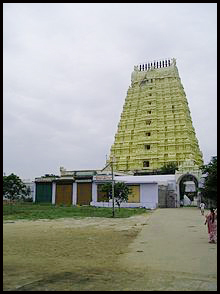Ekambaranathar Temple (Tamil: ஏகாம்பரநாதர் கோயில்) or Ekambareswarar Temple is a Hindu temple dedicated to Shiva,
located in Kanchipuram in the state of Tamil Nadu, India. The temple is the largest temple in the town of Kanchipuram and is located
in the northern part of the town.[1] The temple gopuram (gateway tower) is 59m tall, which is one the tallest gopurams in India.[2]
It is one of the five major Shiva temples or Pancha Bootha Sthalams (each representing a natural element) representing the
element - Earth. The other four temples in this category are Thiruvanaikaval Jambukeswara (water), Chidambaram Natarajar (Sky),
Thiruvannamalai Arunachaleswara (fire) and Kalahasti Nathar (wind). It is one of the 275 Paadal Petra Sthalams, where all of the four
most revered Nayanars (Saivite Saints) have sung the glories of this temple.
Legend
Legend has it that once Parvati, the consort of Shiva was doing penance under the temple's ancient Mango tree near Vegavathi
river. In order to test her devotion Shiva sent fire on her. Goddess Parvati prayed to her brother, Vishnu, for help. In order to save her, he took the Moon from Shiva's head and showed the rays which then cooled down the tree as well as Parvati. Shiva again sent the river Ganga (Ganges) to disrupt Parvati's penance. Parvati prayed to Ganga and convinced her that both of them were sisters and so should not harm her. Subsequently, Ganga did not disturb her penance and Parvati made a Shiva Linga out of sand
to get united with Shiva. The God here came to be known as Ekambareswarar or "Lord of Mango Tree". Pillar inside the temple According to another legend, it is believed that Parvati worshipped Shiva in the form of a Prithivi Lingam (or a Lingam improvised out of sand), under a mango tree. Legend has it that the neighboring Vegavati river overflowed and threatened to engulf the Shiva Lingam and that Parvati or Kamakshi embraced the Lingam. Shiva touched by the gesture materialized in person and married her. In this context he is referred to as Tazhuva kuzhainthaar ("He who melted in Her embrace") in Tamil.
Tiurkuripputhonda Nayanar, one of the 63 saivite saints, called nayanars was a washerman in near the temple and he washed the
clothes of all the Saivities. He was divinely tricked by God Shiva appearing as an aged brahmin and asked him to wash before dawn.
At the same time Shiva made a cloudly evening. On observing the approach of the evening, the washerman banged his head in a
stone in disappointment. God appeared in his true form and graced his devotee.
History
This vast temple is one of the most ancient in India having been in existence since at least 600 AD. Second century AD Tamil poetry
speaks of Kama kottam, and the Kumara kottam (currently the Kamakashi Amman temple and the Subramanya temple).Initially
temple was built by Pallavas. The Vedantist Kachiyapper served as a priest at the temple. The existing structure then, was pulled
down and rebuilt by the later Chola Kings. Adi Sankara, the 10th-century saint got Kanchipuram remodelled along with expansion of
this temple along with Kamakshi Amman temple and Varadaraja Perumal Temple with the help of local rulers.
The Vijayanagar kings, during the 15th century, also made lot of contributions to the temple and later developed by Vallal
Pachiyappa Mudaliar used to go regularly from Chennai to Kanchipuram to worship in this temple, he spent significant money he
amazed during British rule on the temple renovation, Pachiyappa Mudaliar seated at horse back can be seen in the temple pillar. At
the later stage a similar temple with same name Ekambareswarar was constructed in Chennai by Pachiappa Mudaliar in order to
avoid travelling time to Kanchipuram. The Archaeological Survey of India report of 1905-06 indicates wide spread renovation
activities carried out in the temple by Nattukottai Chettiar.
Temple
The central figures are a dancing Shiva, his consort Pavarti and in front, elephant-headed Ganesh The temple covers an area of
over 23 acres (93,000 m2). Reaching a height of 59 meters, the temple's Raja gopuram (the entrance tower to the temple) is one of
the tallest in South India. One notable feature of the temple is the Aayiram Kaal Mandapam, or the "hallway with a thousand pillars",
which was built by the Vijayanagar Kings. The temple's inner walls are decorated with an array of 1,008 Siva lingams. The campus is
25 acres with 5 prakarams (or courtyards) and has a thousand-pillared hall. Kampai Tirtha, the temple tank is believed to have an
underground holy river. The fourth courtyard contains a small Ganesha temple and a pond. The third courtyard contains lot of
smaller shrines. The sanctum sanctorum contains the lingam along with the image of Shiva.
There is no separate shrine for Parvati within the complex as with other Shiva temples in Kanchipuram. A local belief is that
Kamakshi Amman Temple is the consort for Ekambaranathar. There is a small shrine for Vishnu named Thiru Nilaaththingal
Thundathan inside the temple complex. Vishnu is prayed as Vamana Murthy and the shrine is hailed by the Alvar saints as one of
the 108 Divya Desams. The sthala-virutcham or temple tree is a 3,500 year old mango tree whose branches are said to yield four different types of mangoes from its four branches. Panguni Uthiram festival celebrated during the month of March–April is the most popular of all the temple festivals in Kanchipuram.
